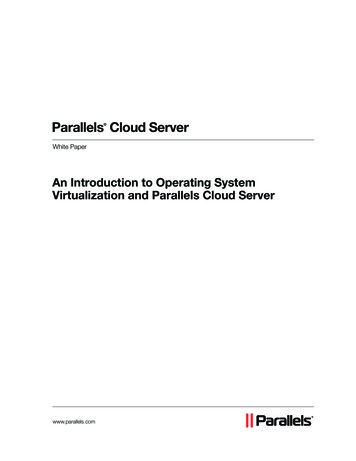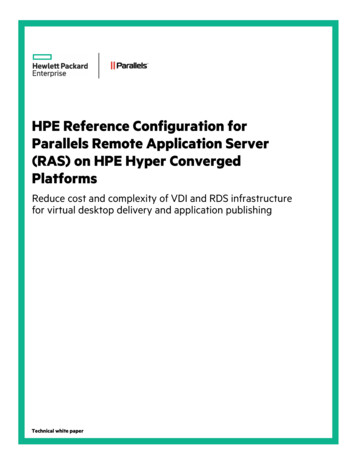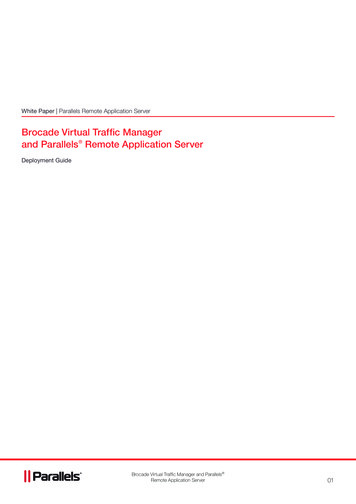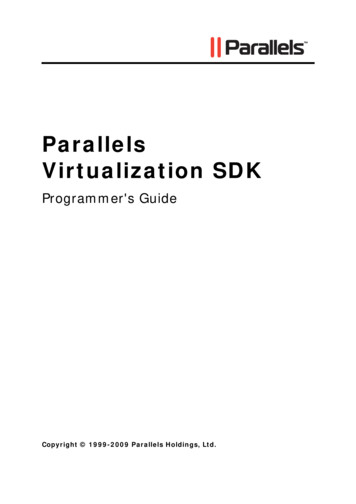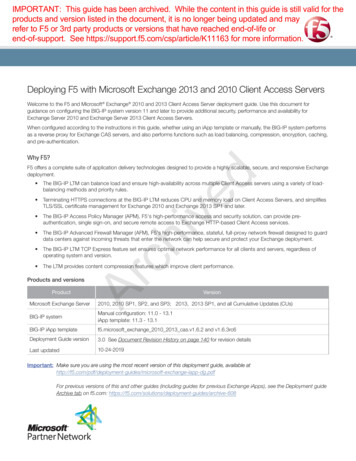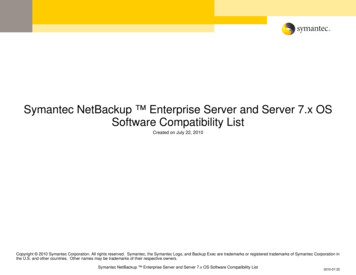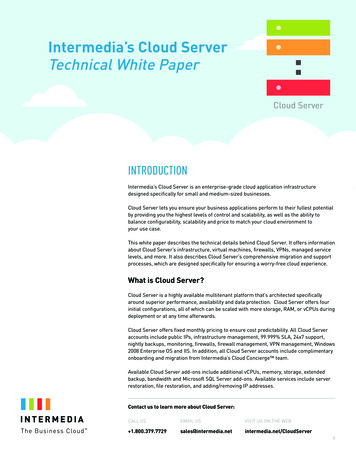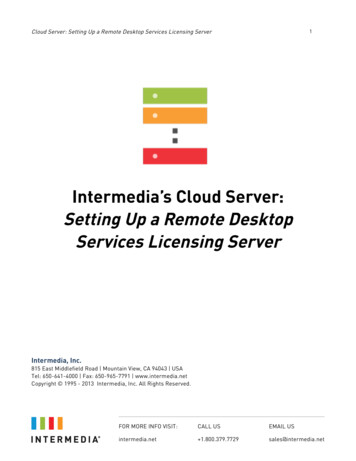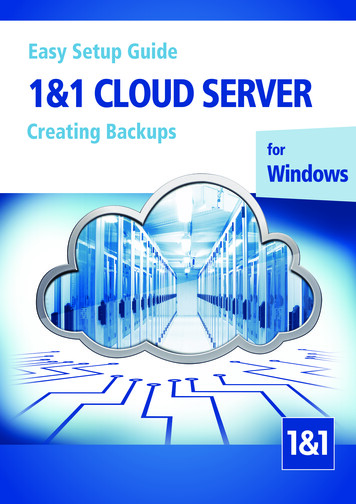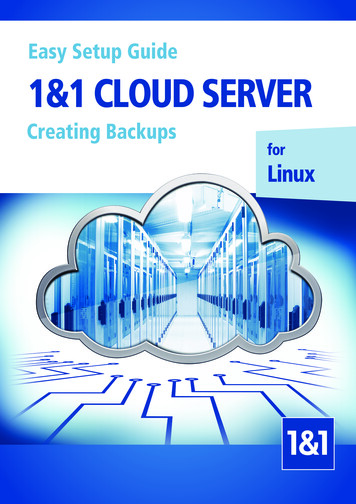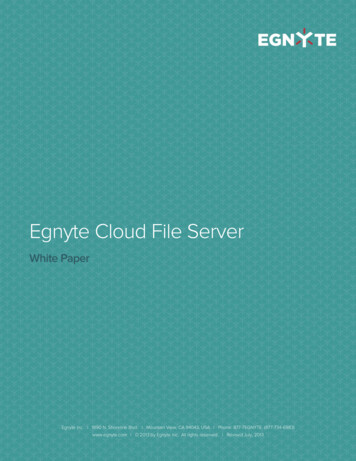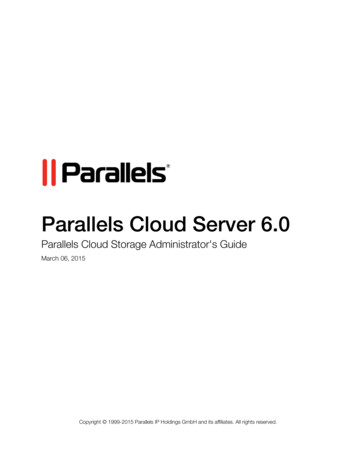
Transcription
Parallels Cloud Server 6.0Parallels Cloud Storage Administrator's GuideMarch 06, 2015Copyright 1999-2015 Parallels IP Holdings GmbH and its affiliates. All rights reserved.
Parallels IP Holdings GmbHVordergasse 598200 SchaffhausenSwitzerlandTel: 41 52 632 0411Fax: 41 52 672 2010www.parallels.comCopyright 1999-2015 Parallels IP Holdings GmbH and its affiliates. All rights reserved.This product is protected by United States and international copyright laws. The product’s underlying technology,patents, and trademarks are listed at http://www.parallels.com/trademarks.Microsoft, Windows, Windows Server, Windows NT, Windows Vista, and MS-DOS are registered trademarks of MicrosoftCorporation.Apple, Mac, the Mac logo, Mac OS, iPad, iPhone, iPod touch, FaceTime HD camera and iSight are trademarks of AppleInc., registered in the US and other countries.Linux is a registered trademark of Linus Torvalds.All other marks and names mentioned herein may be trademarks of their respective owners.
ContentsIntroduction . 7About This Guide . 7About Parallels Cloud Storage . 7Parallels Cloud Storage Architecture . 8Parallels Cloud Storage Configurations . 10Minimum Configuration. 10Recommended Configuration . 11System Requirements . 12Network Requirements . 13Setting Up a Parallels Cloud Storage Cluster . 15Setup Overview . 15Configuring Cluster Discovery . 16Using DNS Records . 16Setting Up Zeroconf . 18Specifying MDS Servers Manually . 18Checking Data Flushing . 19Preparing Disks for Parallels Cloud Storage . 20Setting Up the First Metadata Server . 21Stage 1: Preparing to Create the First MDS Server . 22Stage 2: Creating the First MDS Server . 22Setting Up Chunk Servers . 23Stage 1: Preparing to Create a Chunk Server . 24Stage 2: Creating a Chunk Server . 24Setting Up Clients . 25Stage 1: Preparing to Mount the Cluster . 25Stage 2: Mounting the Cluster . 26Stage 3: Configuring Virtual Machines and Containers . 26Configuring Parallels Cloud Storage Clusters . 28Configuring MDS Servers . 28Adding MDS Servers . 29
ContentsRemoving MDS Servers . 30Configuring Chunk Servers . 30Adding New Chunk Servers to Increase Disk Space. 31Removing Chunk Servers . 31Configuring HDD Hot Plugging . 32Configuring Clients . 34Adding Clients . 35Updating Clients . 35Removing Clients . 35Configuring High Availability . 35Managing Cluster Parameters. 36Cluster Parameters Overview . 36Configuring Replication Parameters . 36Configuring Failure Domains . 37Using Storage Tiers . 40Changing Parallels Cloud Storage Cluster Network . 42Managing Parallels Cloud Storage Licenses . 43Obtaining the Hardware Node ID . 43Installing the License . 43Updating the License. 44Viewing the License Contents. 44Checking the License Status . 45Shutting Down Parallels Cloud Storage Clusters . 46Exporting Parallels Cloud Storage Cluster Data . 47Accessing Parallels Cloud Storage Clusters via NFS. 47Accessing Parallels Cloud Storage Clusters via iSCSI . 48Preparing to Work with Parallels Cloud Storage iSCSI Targets . 50Creating and Running Parallels Cloud Storage iSCSI Targets . 50Listing Parallels Cloud Storage iSCSI Targets . 51Transferring Parallels Cloud Storage iSCSI Targets Between Parallels Cloud Storage Nodes 52Stopping Parallels Cloud Storage iSCSI Targets . 53Deleting Parallels Cloud Storage iSCSI Targets . 53Accessing Parallels Cloud Storage iSCSI Targets from Operating Systems and Third-PartyVirtualization Solutions . 53Configuring Multipath I/O for Parallels Cloud Storage iSCSI Targets . 62
ContentsManaging CHAP Accounts for Parallels Cloud Storage iSCSI Targets . 63Managing LUN Snapshots. 64Monitoring Parallels Cloud Storage Clusters . 66Monitoring General Cluster Parameters . 66Monitoring Metadata Servers . 68Monitoring Chunk Servers . 70Understanding Disk Space Usage . 71Exploring Chunk States . 74Monitoring Clients . 74Monitoring Physical Disks . 76Monitoring Event Logs. 77Monitoring the Status of Replication Parameters . 80Managing Cluster Security . 81Security Considerations . 81Securing Server Communication in Clusters. 81Cluster Discovery Methods . 83Parallels Cloud Storage Ports . 83Password-based Authentication . 86Installations via PXE Servers . 87Maximizing Cluster Performance . 88Exploring Possible Disk Drive Configurations . 88Carrying Out Performance Benchmarking . 89Using 1 GbE and 10 GbE Networks. 90Setting Up Network Bonding . 90Using SSD Drives . 92Configuring SSD Drives for Write Journaling . 93Configuring SSD Drives for Data Caching . 96Improving High-Capacity HDD Performance . 98Improving Virtual Disk Performance . 99Appendices . 100Appendix A - Troubleshooting . 100Submitting Problem Reports to Technical Support . 100Out of Disk Space . 101
ContentsPoor Write Performance . 102Poor Disk I/O Performance . 102Hardware RAID Controller and Disk Write Caches . 102SSD Drives Ignore Disk Flushes. 103Cluster Cannot Create Enough Replicas. 103Failed Chunk Servers. 103Failed Write Journalling SSDs . 105Failed Data Caching SSDs. 105Failed MDS Servers . 105Appendix B - Frequently Asked Questions . 105General. 105Scalability and Performance . 106Availability . 107Cluster Operation . 108Glossary . 111Index . 112
CHAPTER 1IntroductionThis chapter provides basic information about the Parallels Cloud Storage solution and this guide.In This ChapterAbout This Guide . 7About Parallels Cloud Storage . 7Parallels Cloud Storage Architecture . 8Parallels Cloud Storage Configurations . 10System Requirements . 12Network Requirements . 13About This GuideThe guide is intended for system administrators interested in deploying Parallels Cloud Storage intheir networks.The document assumes that you have good knowledge of the Linux command-line interface andextensive experience working with local networks.About Parallels Cloud StorageParallels Cloud Storage is a solution allowing you to quickly and easily transform low-costcommodity storage hardware and network equipment into a protected enterprise-level storage, likeSAN (Storage Area Network) and NAS (Network Attached Storage).Parallels Cloud Storage is optimized for storing large amounts of data and provides replication,high-availability, and self-healing features for your data. Using Parallels Cloud Storage, you cansafely store and run Parallels virtual machines and Containers, migrate them with zero downtimeacross physical hosts, provide high availability for your Parallels Cloud Server installations, andmuch more.
IntroductionParallels Cloud Storage ArchitectureBefore starting the deployment process, you should have a clear idea of the Parallels CloudStorage infrastructure. A typical Parallels Cloud Storage is shown below.The basic component of Parallels Cloud Storage is a cluster. The cluster is a group of physicalcomputers connected to the same Ethernet network and performing the following roles: chunk servers metadata servers client computers (or clients)Brief OverviewAll data in a Parallels Cloud Storage cluster, including Parallels virtual machine and Container diskimages, is stored in the form of fixed-size chunks on chunk servers. The cluster automaticallyreplicates the chunks and distributes them across the available chunk servers to provide highavailability of data.8
IntroductionTo keep track of data chunks and their replicas, the cluster stores metadata about them onmetadata (MDS) servers. The central MDS server, called the master MDS server, monitors allcluster activity and keeps metadata current.Clients manipulate data stored in the cluster by sending different types of file requests, such asmodifying an existing file or creating a new one.Chunk ServersChunk servers store all the data, including the contents of virtual machines and Containers, in theform of fixed-size chunks and provide access to these chunks. All data chunks are replicated andthe replicas are kept on different chunk servers to achieve high availability. If one of the chunkservers goes down, the other chunk servers will continue providing the data chunks that werestored on the failed server.Metadata ServersMetadata (MDS) servers store metadata about chunk servers and control how files keeping thecontents of virtual machines and Containers are split into chunks and where these chunks arelocated. MDS servers also ensure that a cluster has enough chunk replicas and store a global logof all important events that happen in the cluster.To provide high availability for a Parallels Cloud Storage cluster, you need to set up several MDSservers in the cluster. In this case, if one MDS server goes offline, another MDS server will continuekeeping control over the cluster.Note: MDS servers deal with processing metadata only and do not normally participate in any read/writeoperations related to data chunks.ClientsClients are computers with Parallels Cloud Server 6.0 from where you run virtual machines andContainers stored in a Parallels Cloud Storage cluster.Notes:1. You can set up any computer in the cluster to perform the role of a metadata server, chunk server, orclient. You can also assign two or all three roles to one and the same computer. For example, you canconfigure a computer to act as a client by installing Parallels Cloud Server 6.0 on it and running virtualmachines and Containers from the computer. At the same time, if you want this computer to allocate itslocal disk space to the cluster, you can set it up as a chunk server.2. Though Parallels Cloud Storage can be mounted as a file system, it is not a POSIX-compliant filesystem and lacks some POSIX features like ACL, user and group credentials, hardlinks, and some other.9
IntroductionParallels Cloud Storage ConfigurationsThis section provides information on two Parallels Cloud Storage configurations: Minimum configuration (p. 10). You can create the minimum configur
Mar 06, 2015 · Clients are computers with Parallels Cloud Server 6.0 from where you run virtual machines and Containers stored in a Parallels Cloud Storage cluster. Notes: 1. You can set up any computer in the cluster to perform the role of a metadata server, chunk server, or client. You can also as
